POSTS
Fujisan
In mid-April (yes, I realize it’s already almost June), I finally got to experience something we’d been unsuccessful in doing during our various trips to Japan over the past 8 years: I saw Mt. Fuji, and it was incredible.
The trip actually began in Tokyo. We flew down there to meet up with Seri’s best friend, Julie, then to make our way west to the town of Fujikawaguchiko, to the north of the mountain.
Tokyo
Seri and I arrived a bit ahead of Julie, so we were able to drop off our bags at the hotel and grab some lunch. The hotel, Omo5 in Ōtsuka, was new and modern. Our room had kind of a bunk bed layout which reminded me a bit of the rooms in Terrace House.
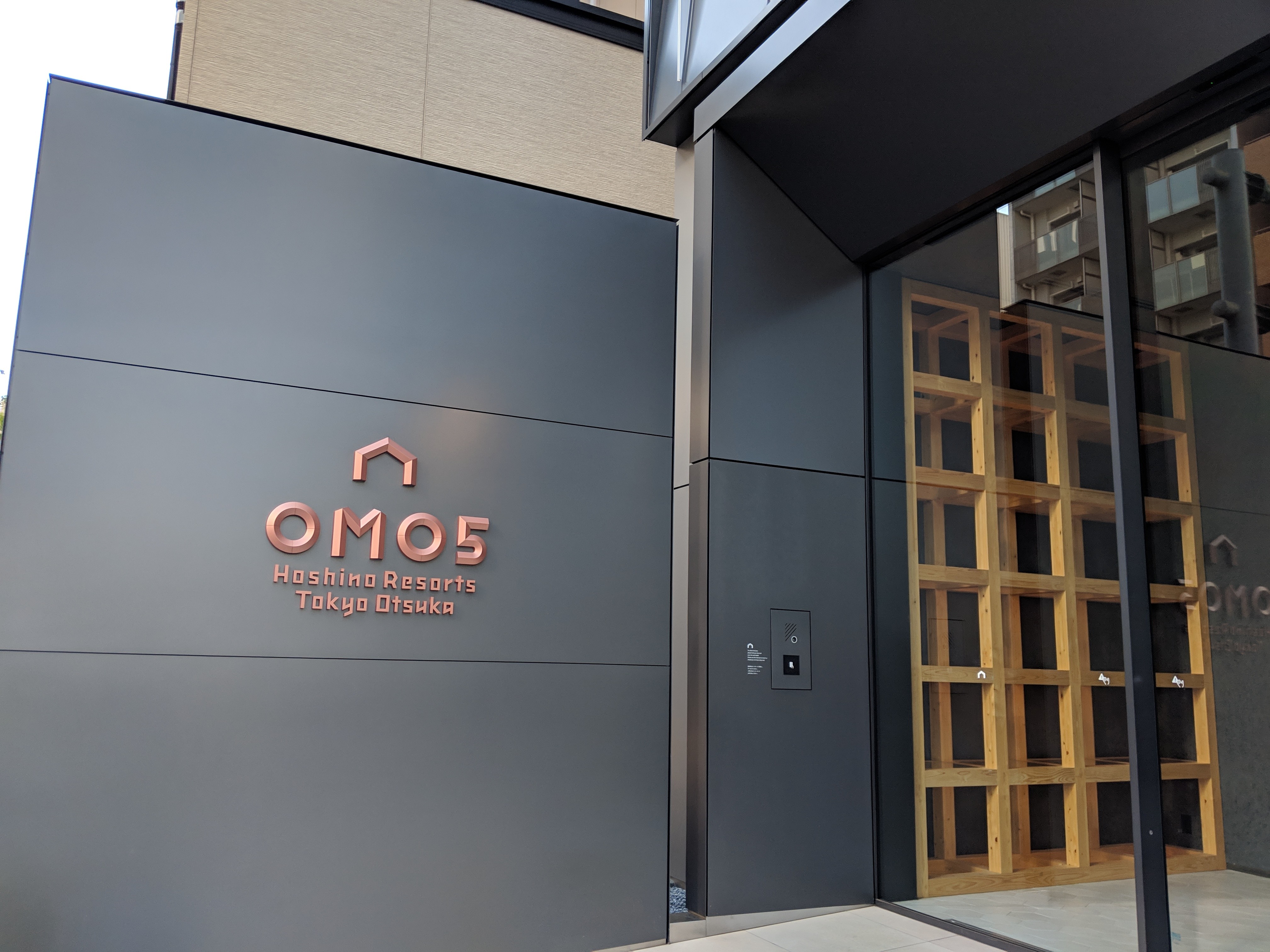
The entrance to our hotel in Ōtsuka
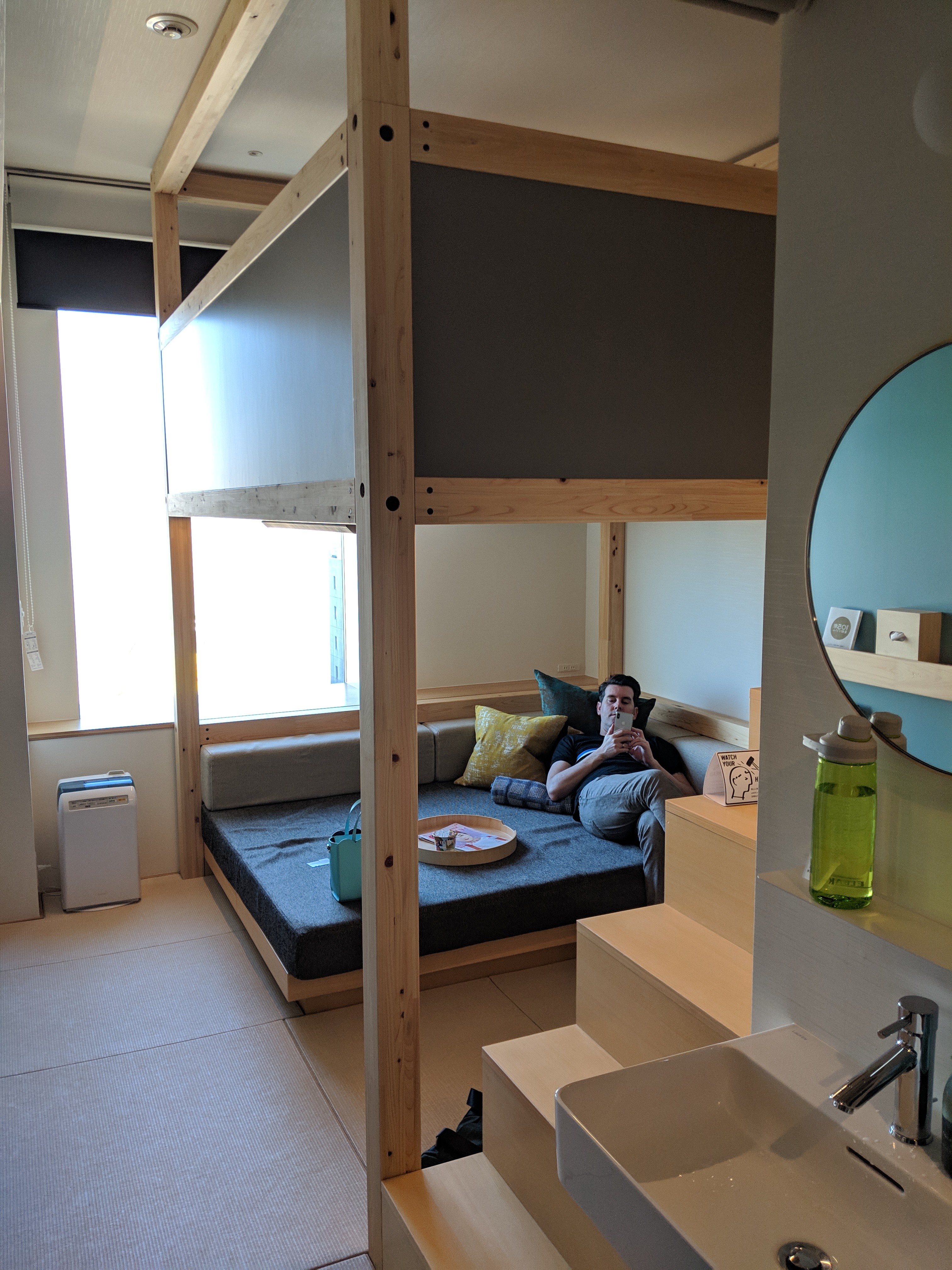
The downstairs area, complete with exhausted-Adam-on-phone
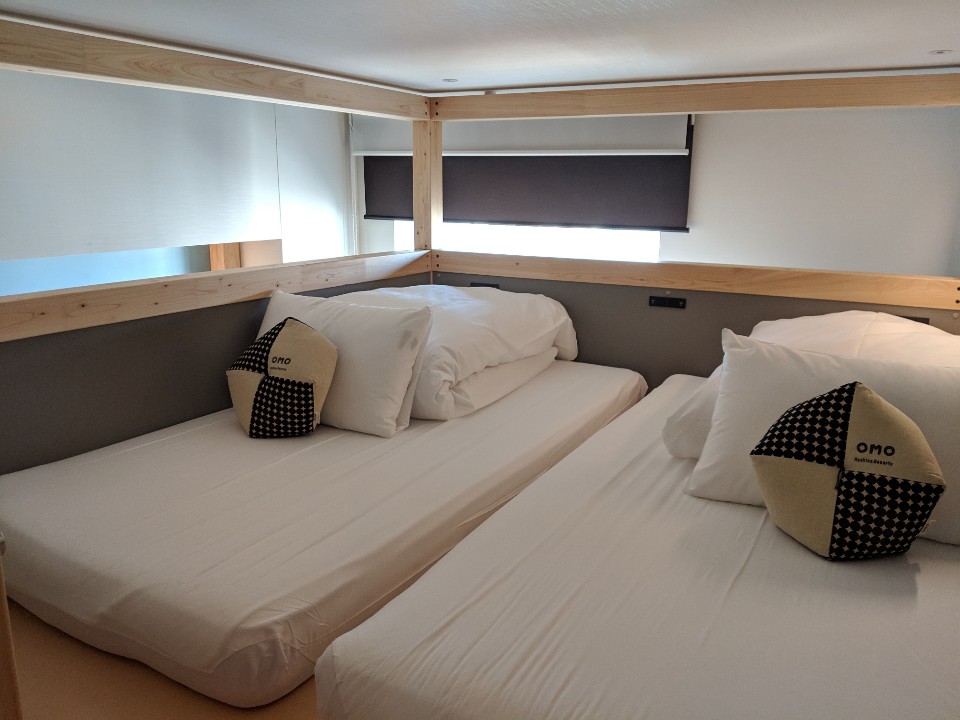
The upstairs bunk area
Backing up a bit — and if I can soapbox a little (verdict: I can, it’s my blog) — I’m not really a huge fan of Tokyo. It has bulk; life; an abundance of cultures. So it’s got that going for it, which is nice. But it’s a double-edged sword: Being in Tokyo doesn’t feel like being in Japan, when I’m there. At lunch that day, half of the customers were foreigners. Obviously that includes me, but there are a number of things that make Tokyo seem like it’s progressively catering to a more international audience (probably because it is). It thins the experience, pouring a bit more water into the pot every time I visit. The more familiar things have become, the less interested I am. They have Taco Bell for crying out loud.
I think for Japan, this is probably a good thing; it’s been culturally closed off enough that any semblance of it opening up makes it feel less like the wacky sitcom character you just sort of look at and roll your eyes towards. “Oh, Japan!” With the Olympics next year, this seems to be becoming more important as well: There are a growing number of TV ads about learning English or devices that help with translation, and programs have sprung up describing different cultures and how people from other countries act/how they’re different. I’m sure there are foreigners who enjoy the familiarity of Tokyo, too, because it’s not “as different” as some places out here. It’s just, selfishly, not as unique an experience as some other places I’ve been to in Japan.
Anyway, once Julie arrived, we set down our things, relaxed a bit, then headed out to a nearby yakitori restaurant for dinner. We capped off the night at a bar close by and walked back to our hotel to end the evening.
We rented a car for the week, as we wanted to be a bit more mobile once we got to Kawaguchiko. That meant a 2-hour drive where the starting point was a bit daunting (driving in Tokyo can be nerve-wracking). Fortunately, once you’re on the main expressway, things get easier — and faster. Seri was the driver for the trip out west. We ran into a bit of a hiccup leaving the city due to not having adequate GPS coverage inside a lengthy tunnel, confusing Google Maps about which exit to take, but managed to find our way eventually.
The first sighting
About an hour and a half from our start in Tokyo, the expressway opened up and… we saw Mt. Fuji. Things in nature generally don’t impress me much, sadly. I see people who feast on mountains, vistas, and lakes, and I wonder what it is about me that just doesn’t “get” it. But Mt. Fuji was different. It’s such a massive formation, towering alone above everything else in sight that you can’t help but be in awe of it. Every other time I’ve tried to view Mt. Fuji while visiting Japan, we’ve either been too far away, or the weather has been too cloudy. Seeing it up close on a clear day was simply stunning. I couldn’t help but keep looking at it, burning it into my memory. Also my camera’s. We took a lot of pictures, y’all.
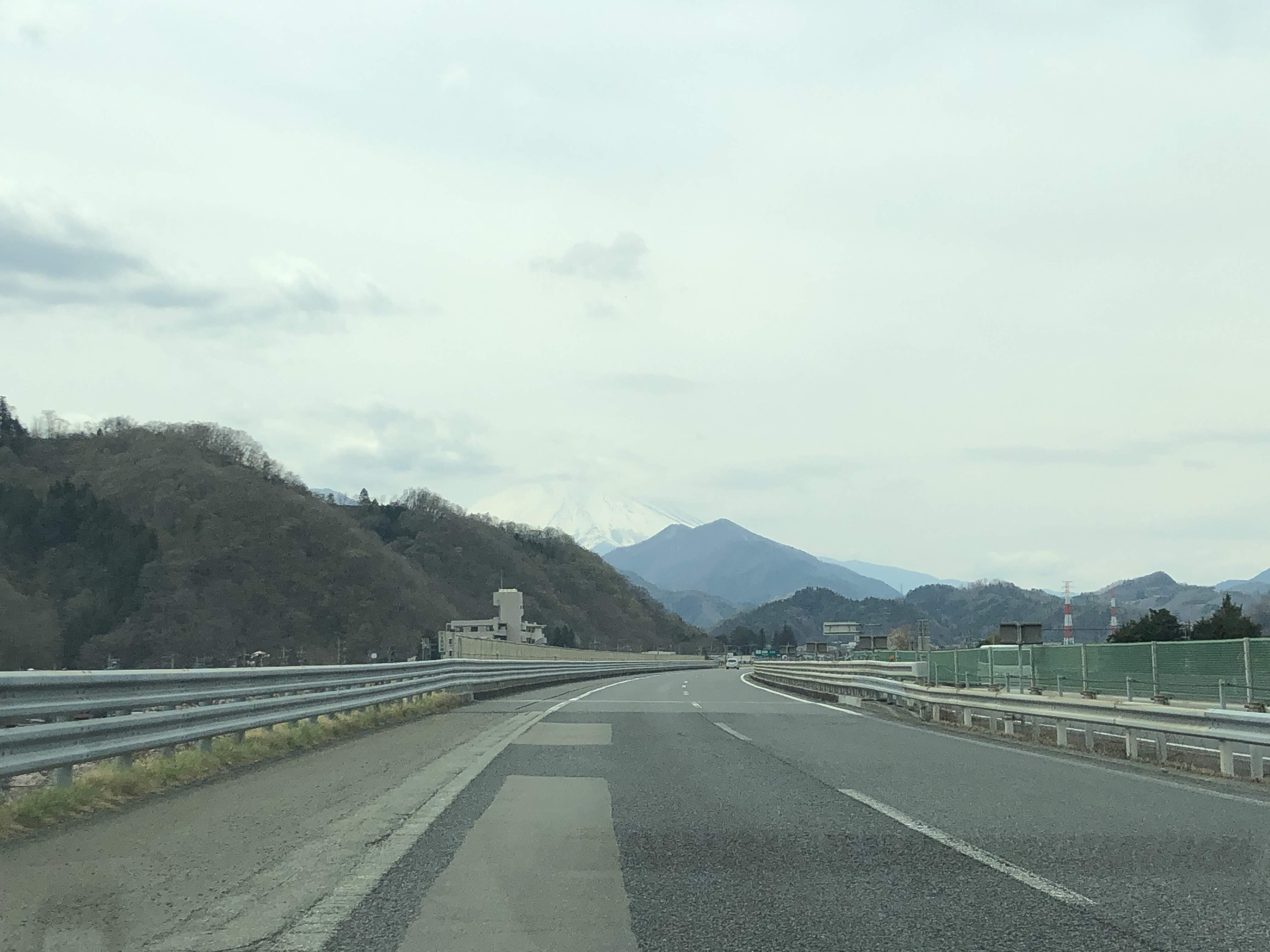
Something snow-capped in the distance...
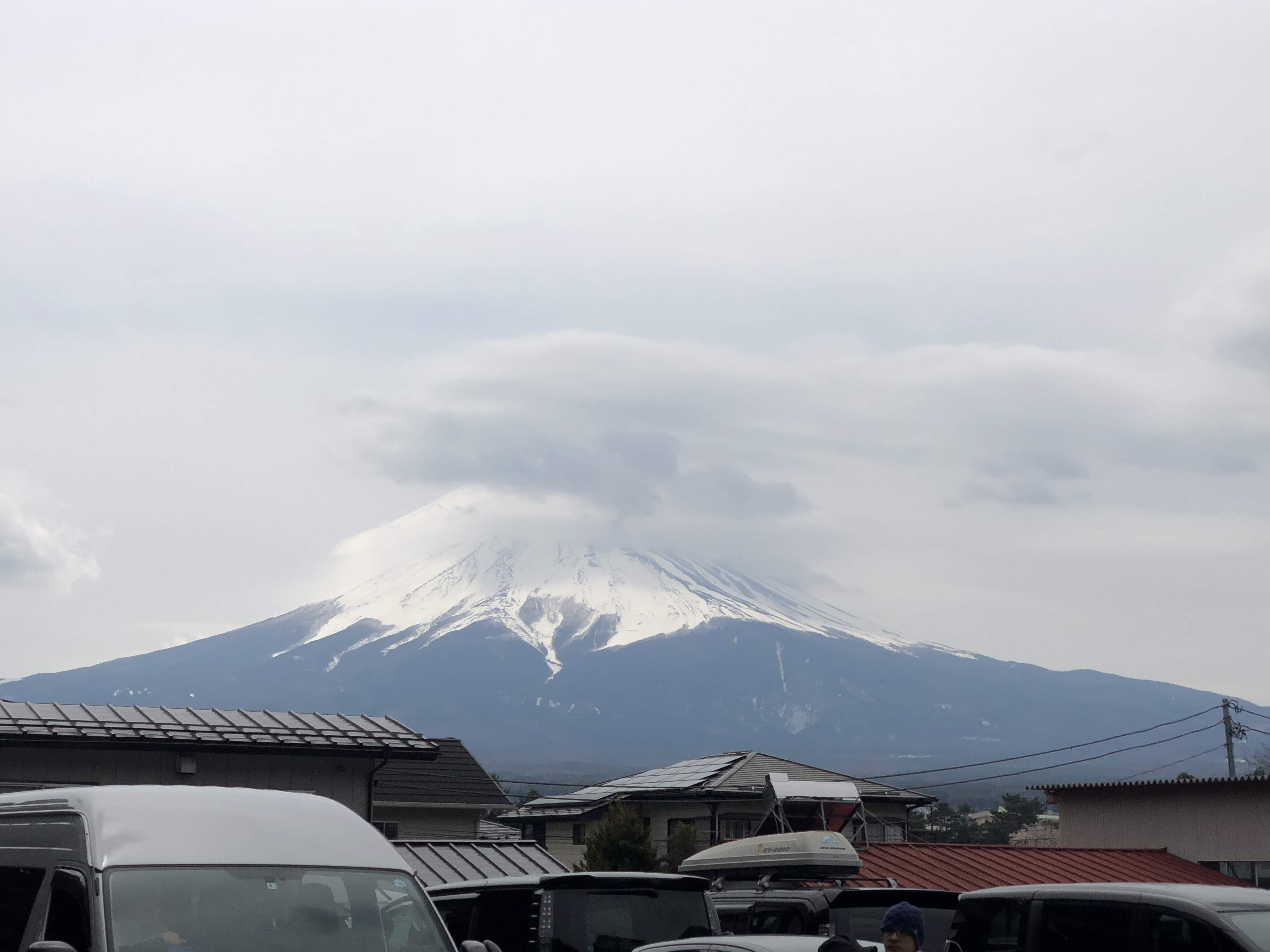
It's here! (go away, cloud)
A bit before we reached Kawaguchiko, we stopped at the Arakurayama Sengen Park. There’s a pagoda there that offers a nice view of Mt. Fuji. It also has a number of cherry blossoms that were coincidentally in bloom when we arrived, which also made for some great photo opportunities. Unfortunately, the photo spot in front of the pagoda had a massive line, and we weren’t about to wait in it to get the same photo as everyone else who visits there. If you want an idea of the view, it looks like this. You’re welcome. Oh also, a number of tourists were tugging on the limbs of the cherry blossom trees, causing flowers to fall and general damage to the trees. So that was nice. I hope their Instagram posts got tons of likes. Hearts?
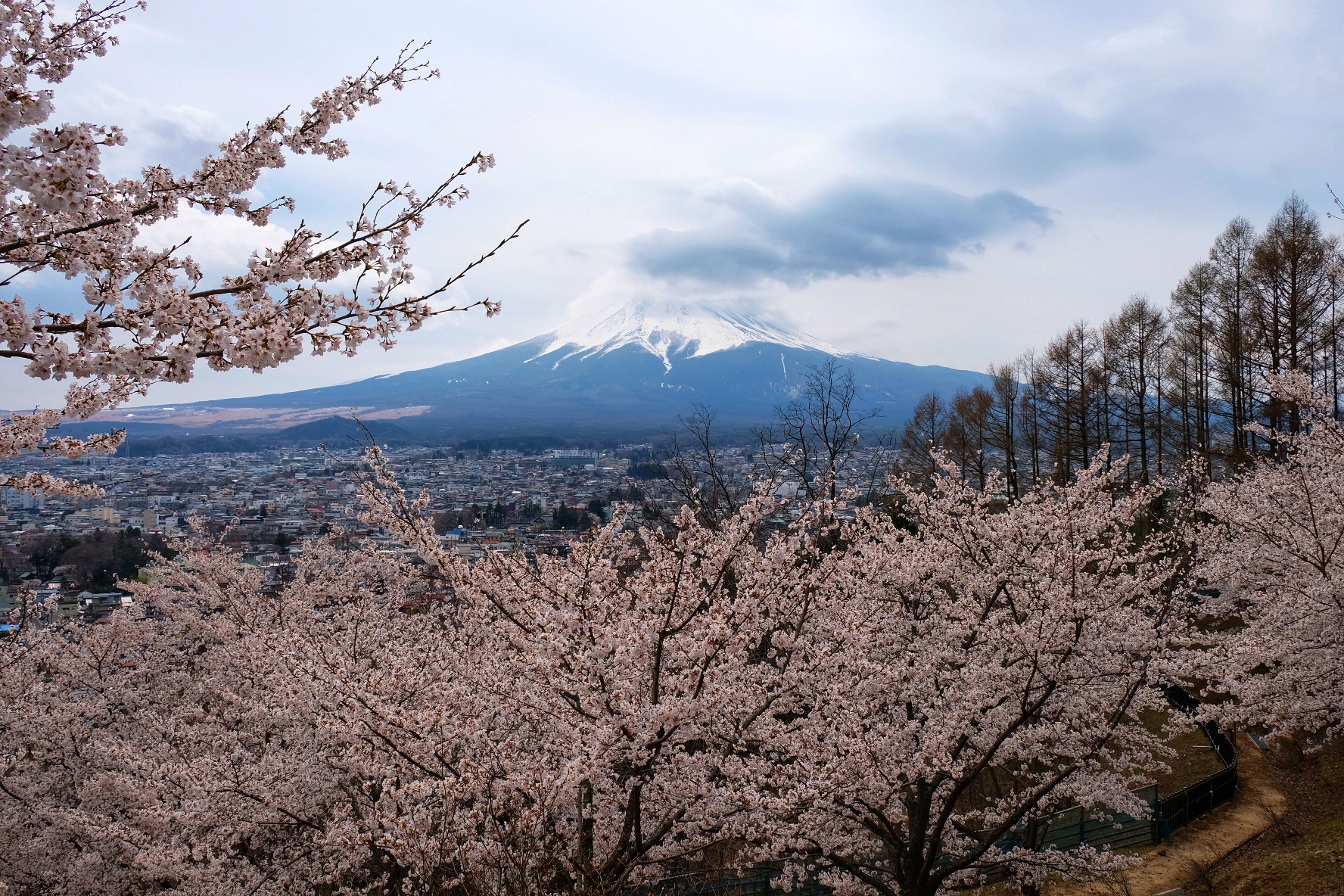
Mt. Fuji surrounded by nearby cherry blossoms
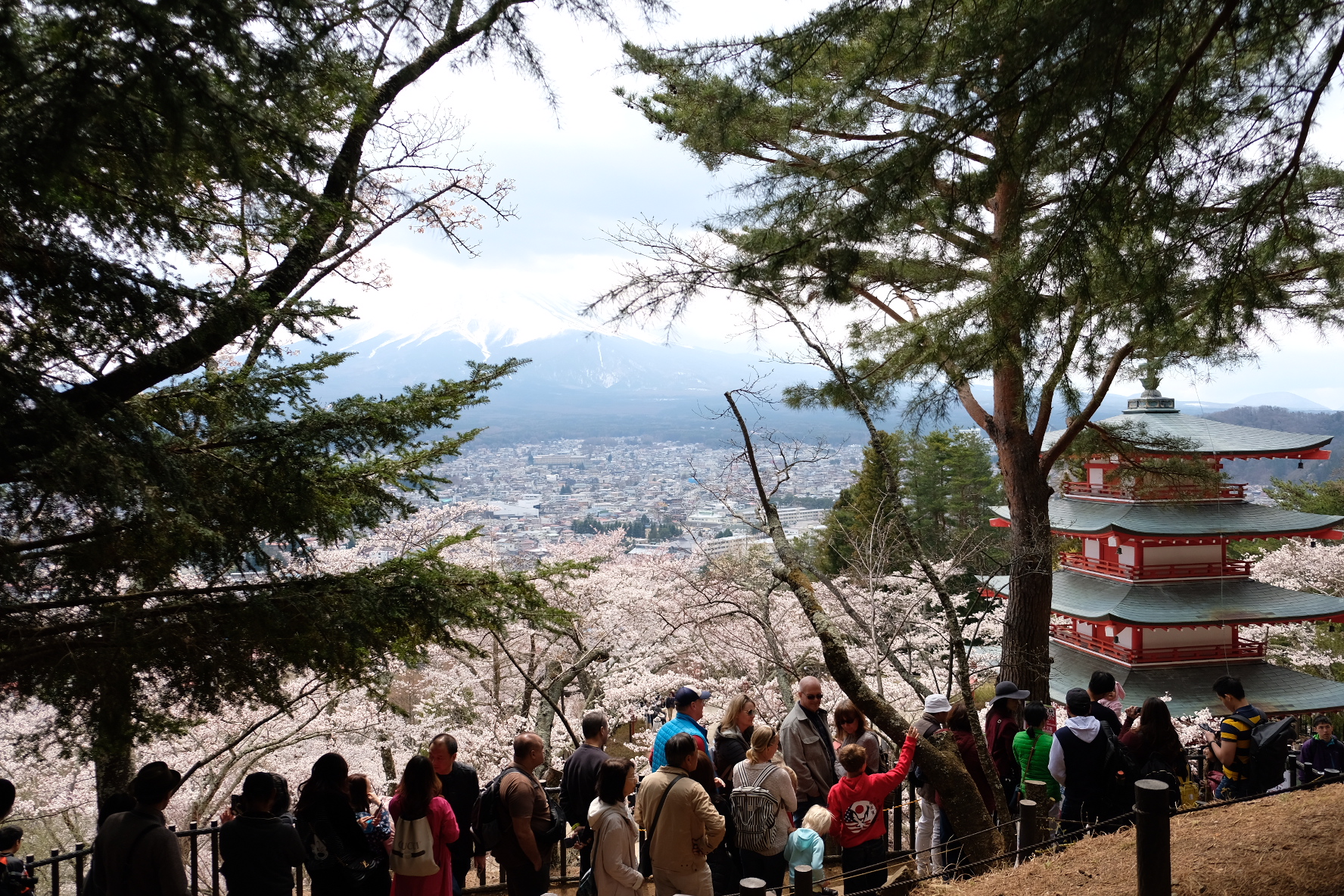
The pagoda line... no thanks
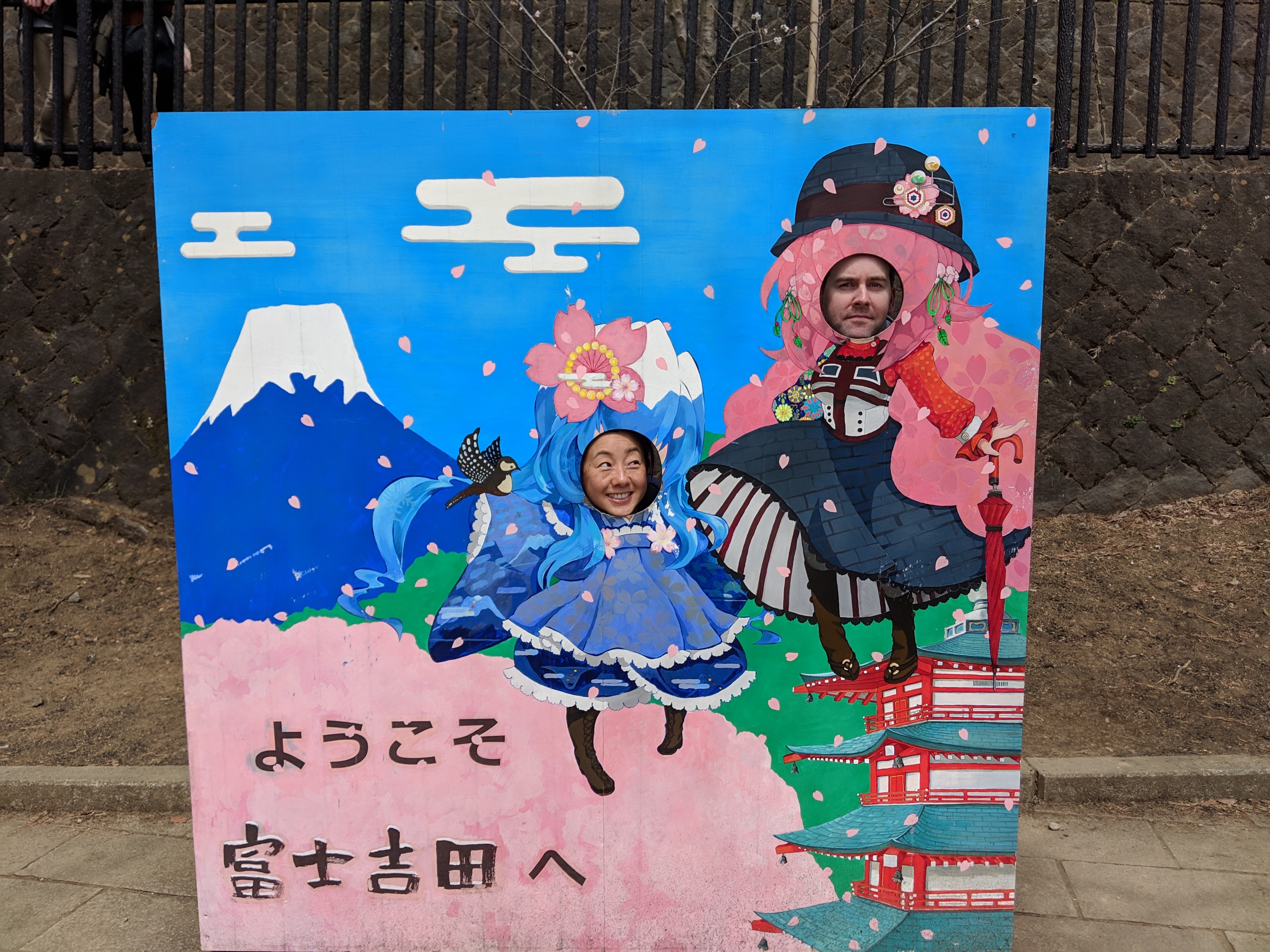
Obligatory cut-out photo
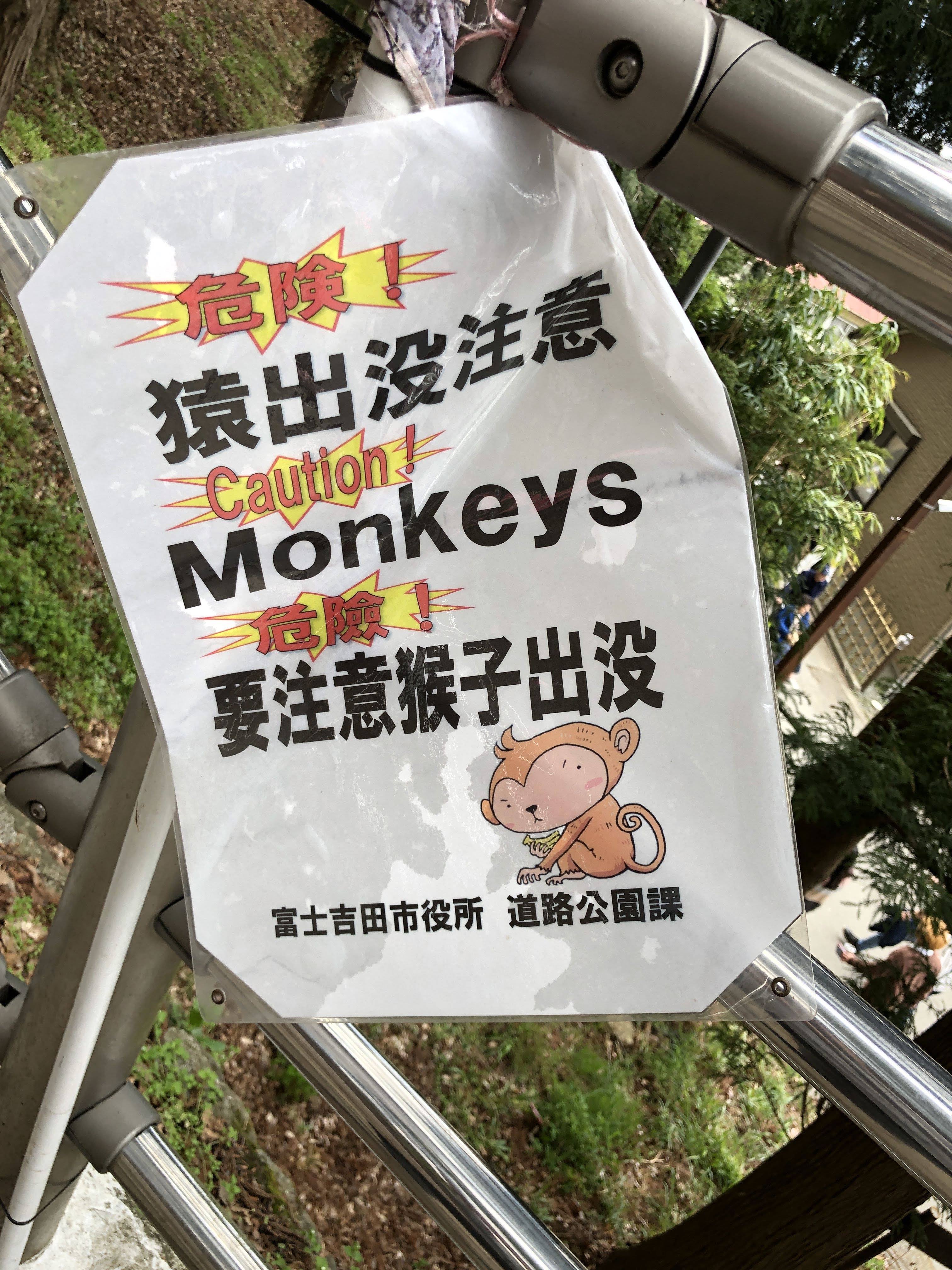
Caution! Monkeys
Kawaguchiko
After the park, we headed to the hotel to drop off our things. We’d booked a room at a the Shuhokaku Kogetsu hotel, which we were told offered great views of the lake and mountain. When we arrived, Seri noticed that her name was written on a board in the entryway, welcoming us to the hotel. Classy!
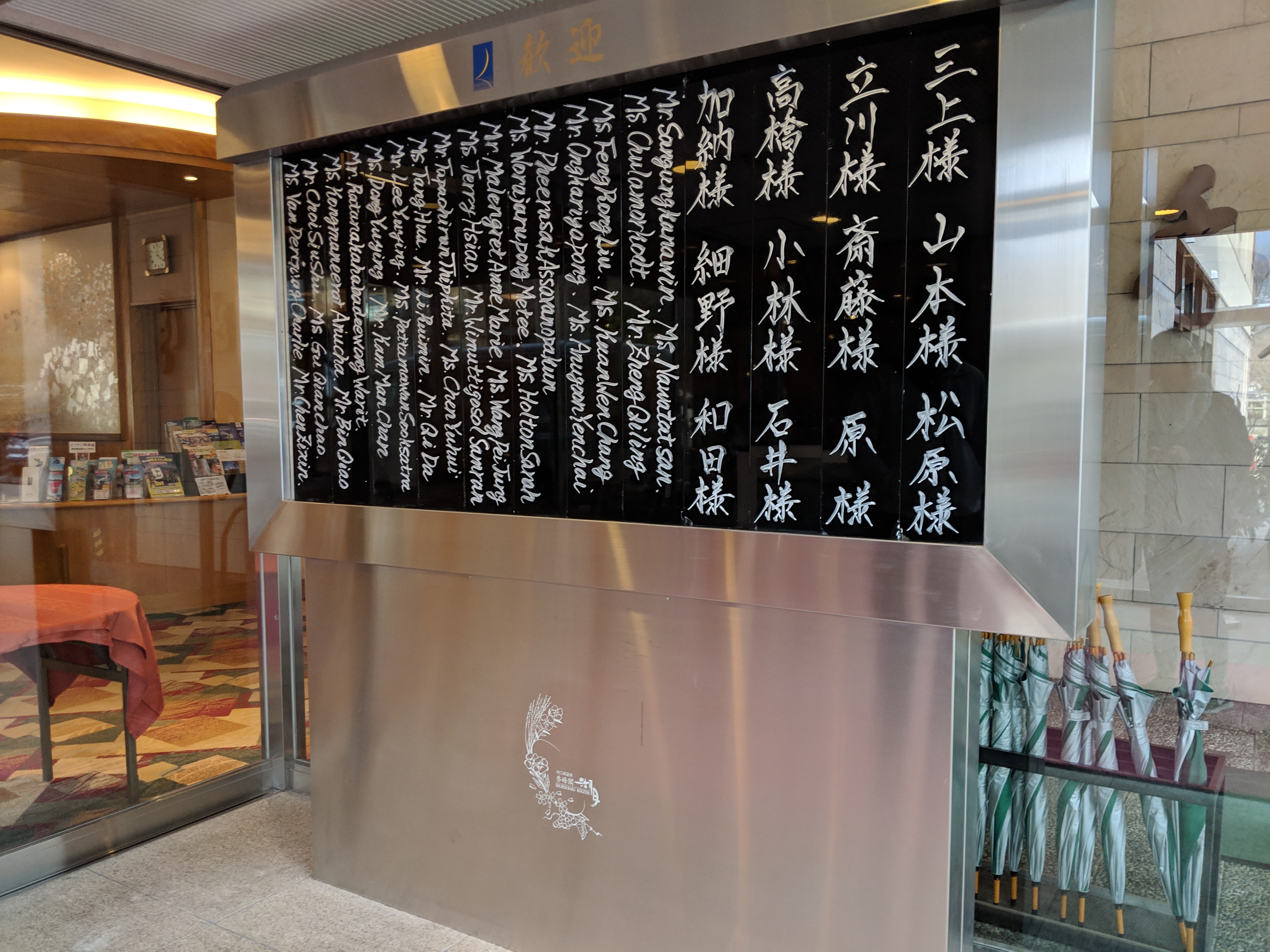
Seri's last name written on the board in the hotel entryway (bottom-right corner, 松原様)
We put down our things, then wandered the lake a bit to take more photos and browse a nearby art fair. Then we hopped in the car to drive a short distance to the Kubota Itchiku Art Museum. Itchiku-san was a master of silk kimono dyeing. He spent over 60 years perfecting his dye technique, practicing his craft effectively up to his death at 86. The entrance reminded us of the viaduct at Park Güell in Barcelona. The main structure housing the kimonos is a huge all-timber construction with massive interior beams. Unfortunately, photography was prohibited inside, but you can get an idea from Google. I figure it’s sorta like when they told us we couldn’t take photos inside the Sistine Chapel but Seri took a candid shot anyway because she’s a criminal.
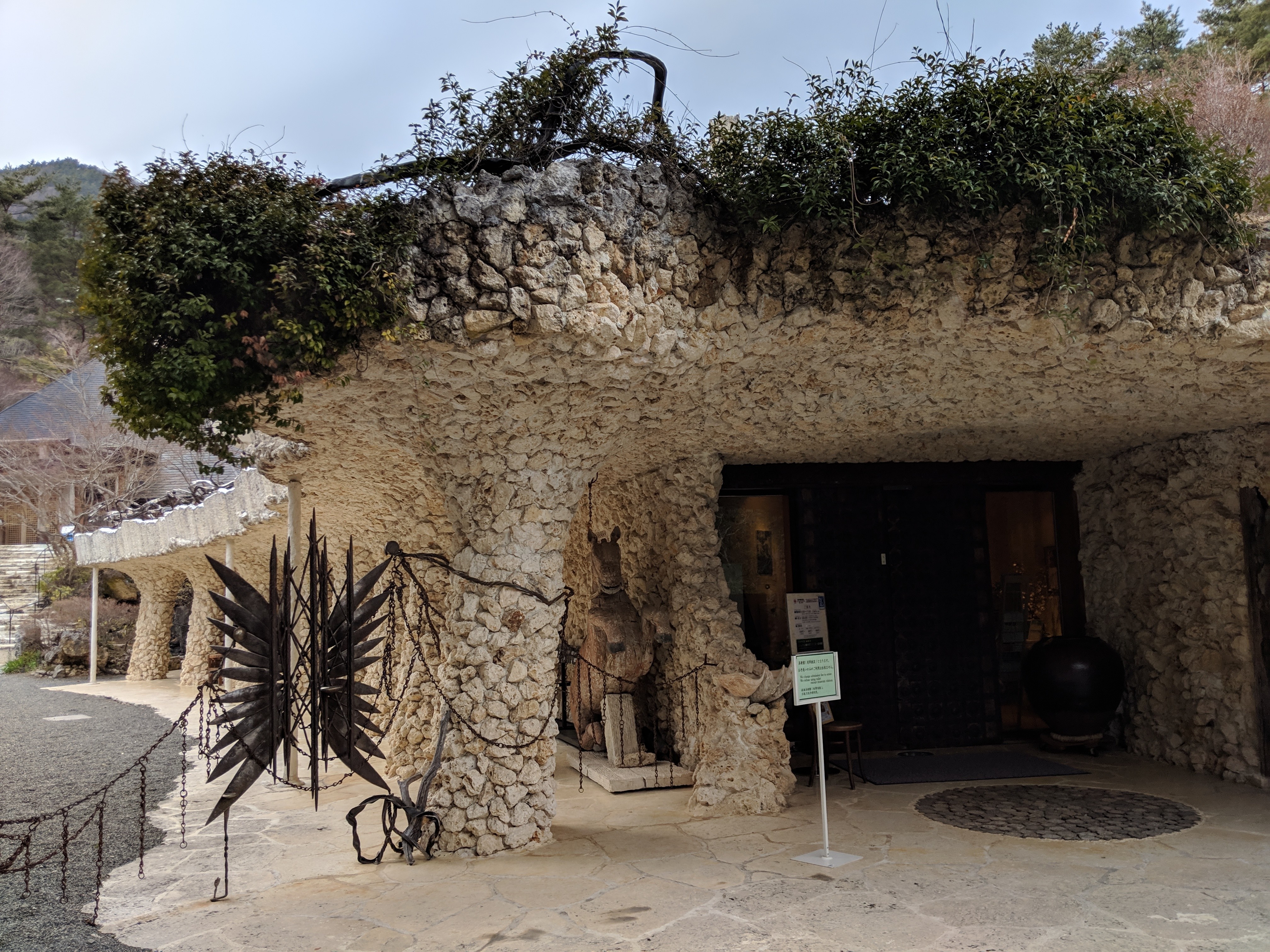
The entrance to the museum
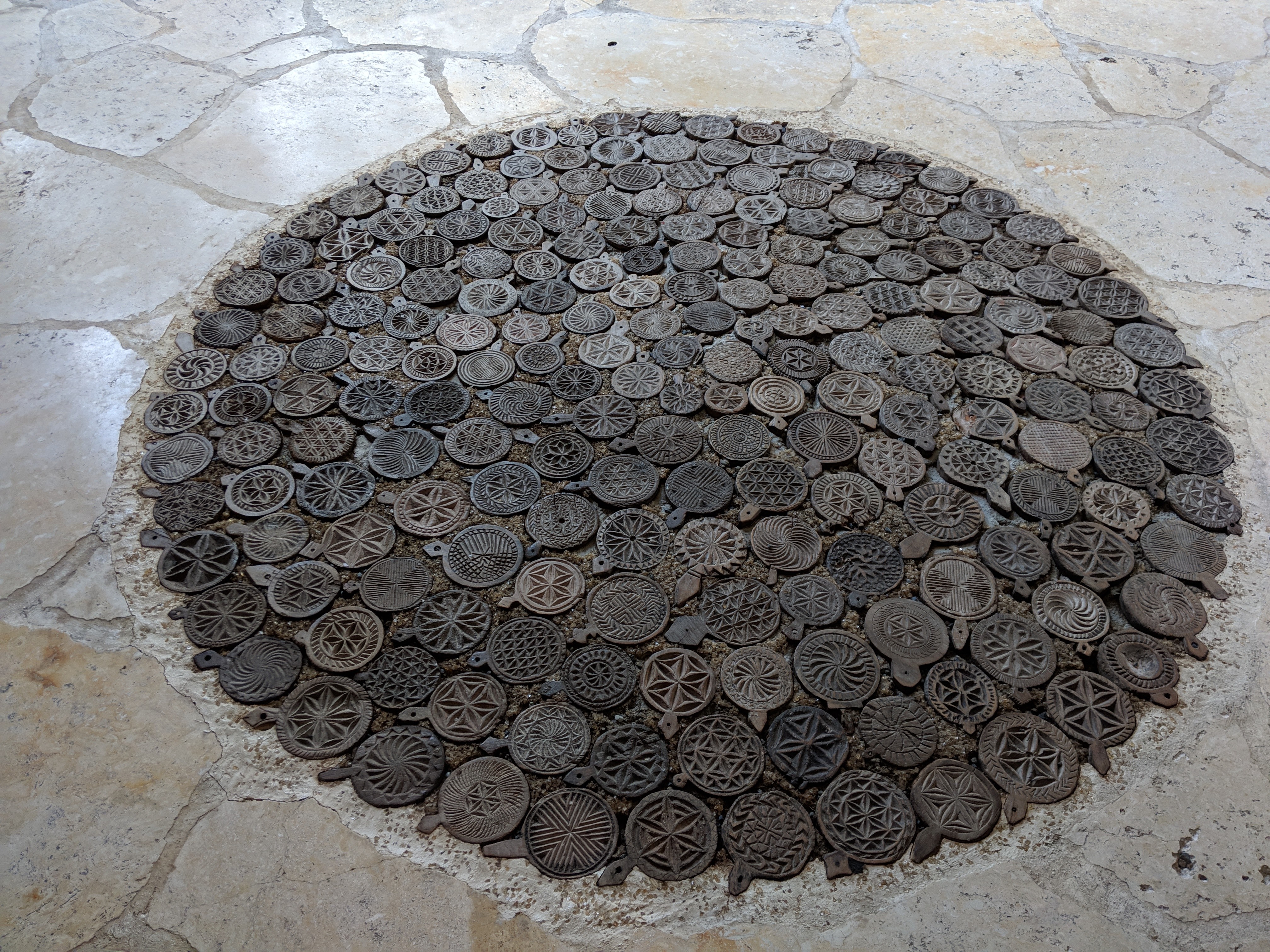
Japanese emblems ("mon") on the ground outside the entrance
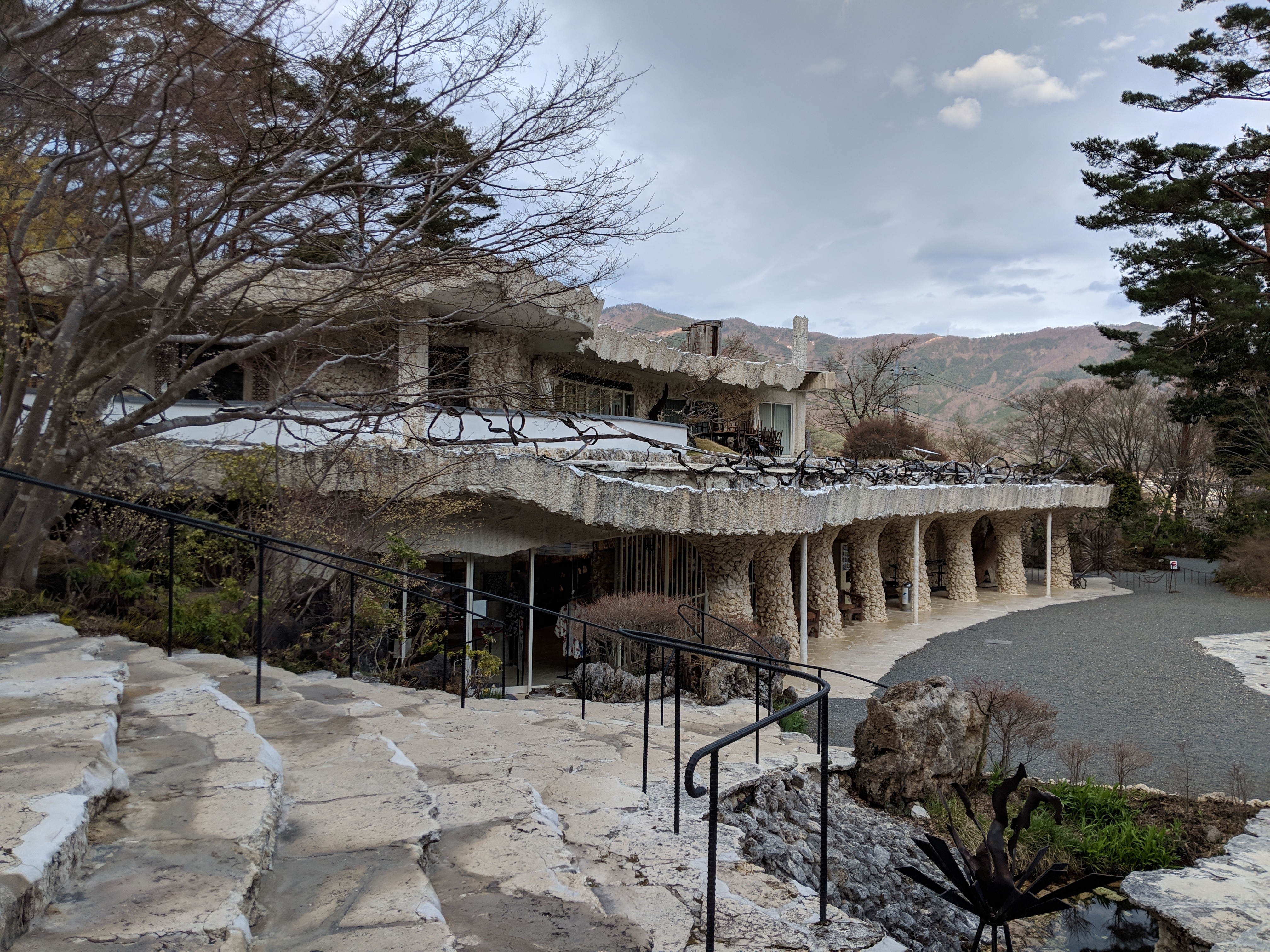
A view of the entry building from further inside the grounds
I’ll be honest, I thought the museum was gonna be a bit of a bust once they suggested we watch a 20-minute video on Itchiku-san’s life. But it really gave me an appreciation for just how much work went into every kimono, especially once you viewed them up close. It was a bit like being at a Grateful Dead concert (or so I’d imagine), except each color was purposeful, and multiple kimono served to describe a larger image. Pretty cool stuff.
By the time we got back to the hotel, dinner was ready. At some ryokan (Japanese-style hotels) — ours included — you take some or all of your meals in your room. It’s nice to be able to relax in your room while a server brings your multi-coursed meal to you. We drank some wine we’d picked up earlier in the day, enjoyed the meal, and took a foot bath on our deck (yeah our room had a foot bath, too, sweet!), and winded down the evening. After a bit, our doorbell rang and two men came in to lay out our futon. These guys were total pros, doing everything in a fluid, synchronized manner. I wish I would’ve gotten video of them doing it, but that might’ve been a tad creepy.
The next morning, we went to the hotel’s onsen for a nice, relaxing morning soak. The rotenburo (open-air bath) had a nice view of Mt. Fuji, but only from a few angles. I waited for one guy to leave so I could get the prime Fujisan viewpoint, and took it all in for a bit. We then headed to the main dining hall to grab breakfast, and take photos on the lawn just outside, which had a few cherry blossoms and a nice view of the lake and mountain.
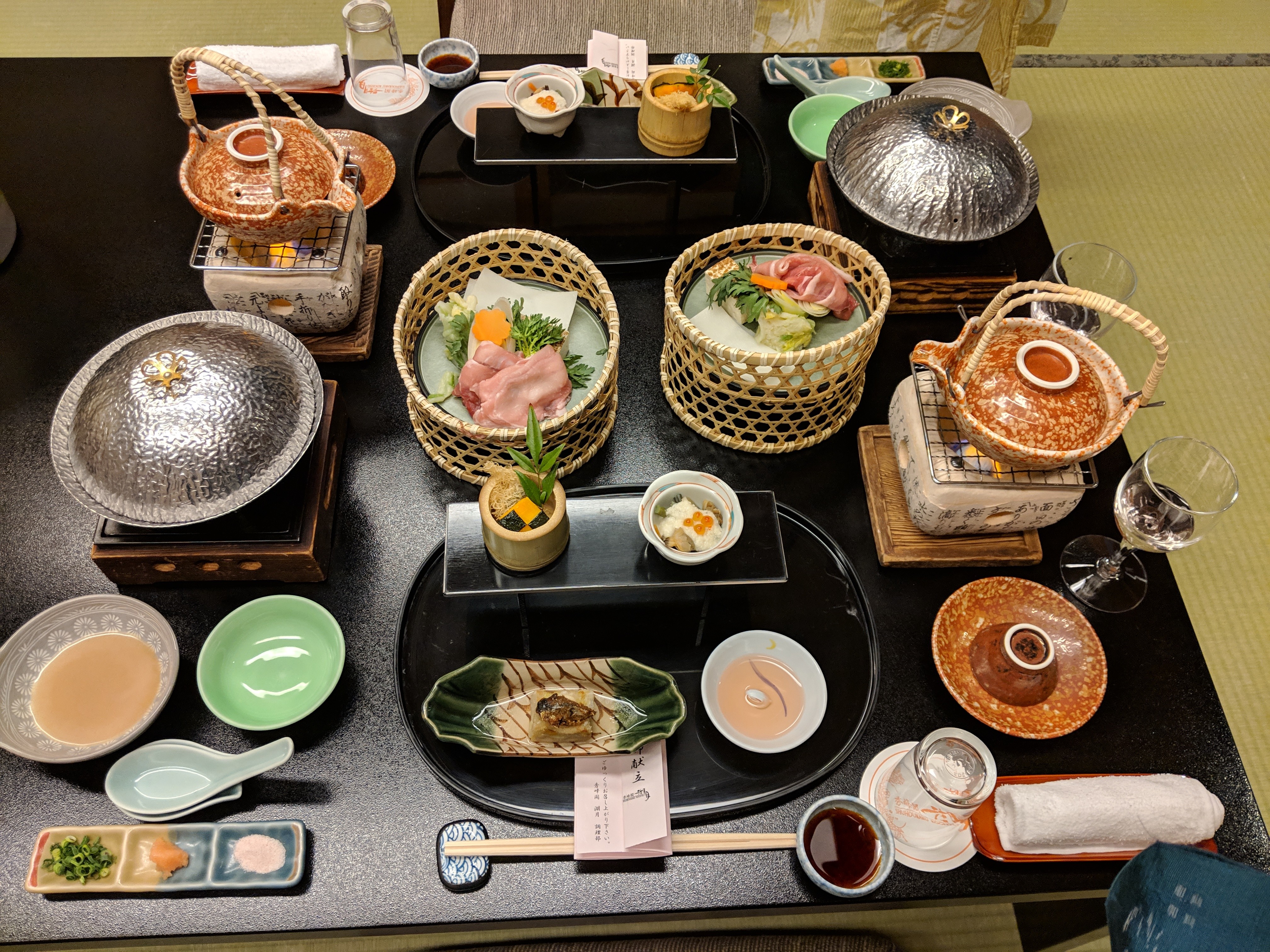
Our dinner at the ryokan
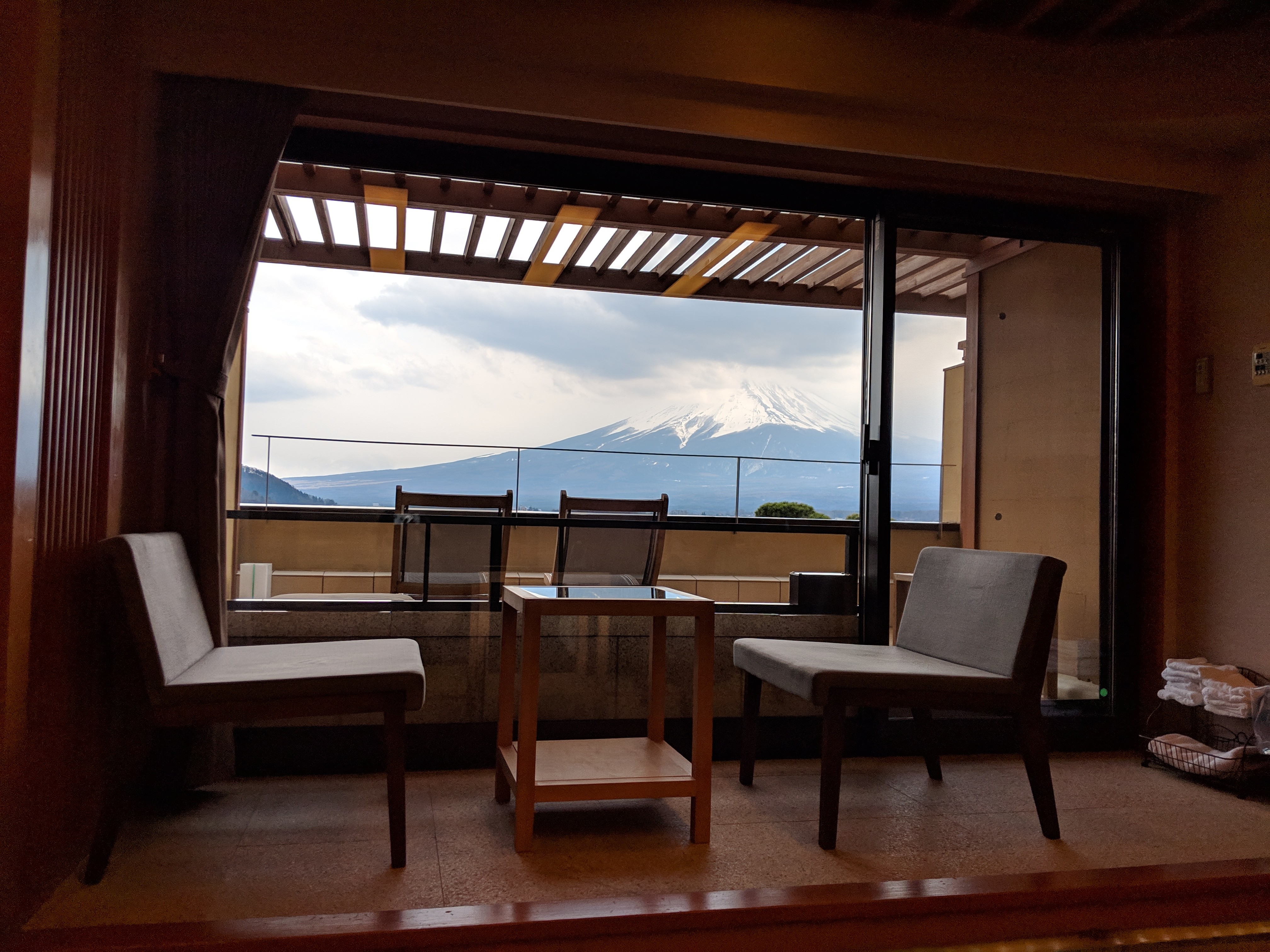
The view from our room
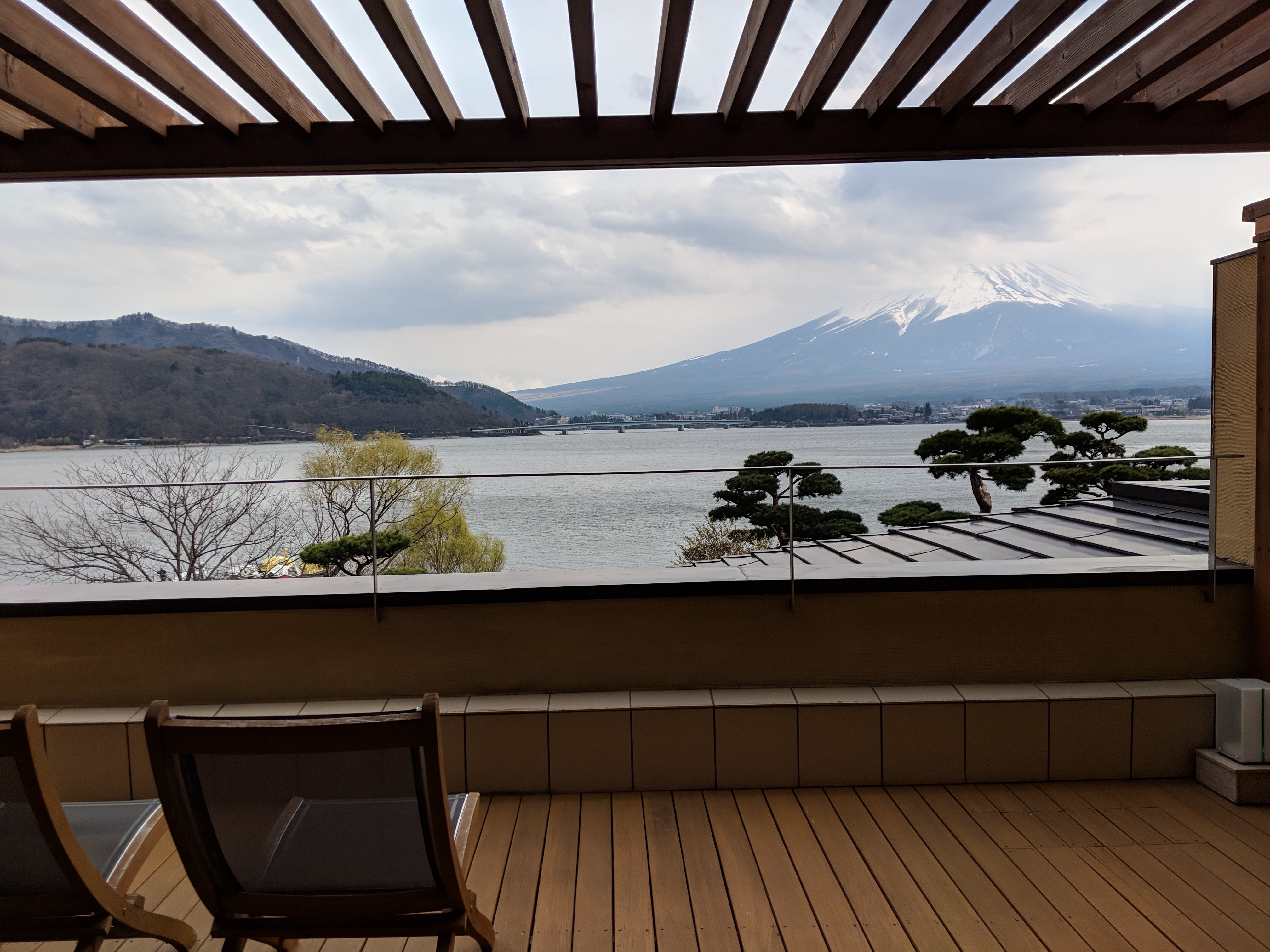
The view from our room's balcony
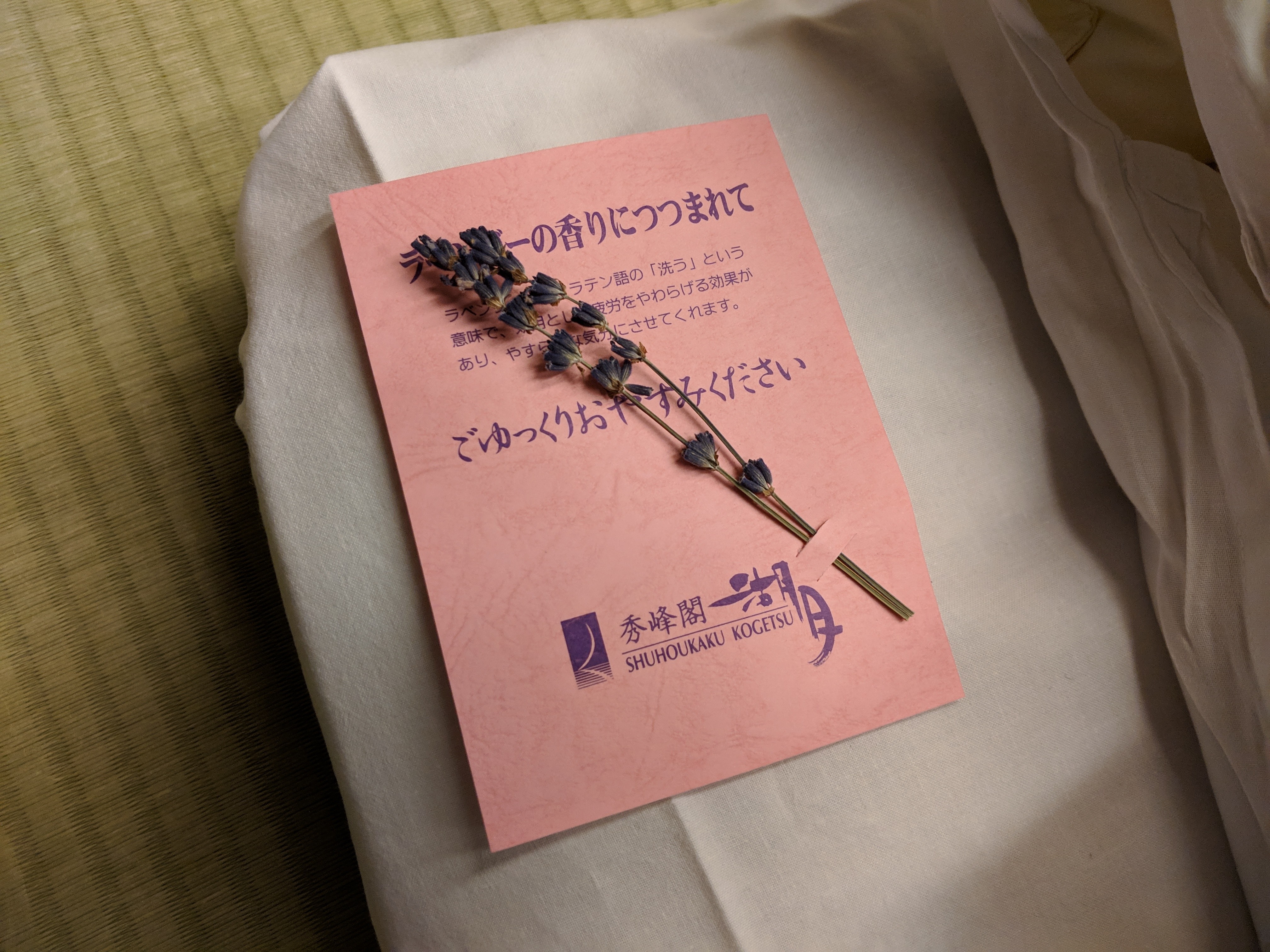
They put fresh lavender on our pillows
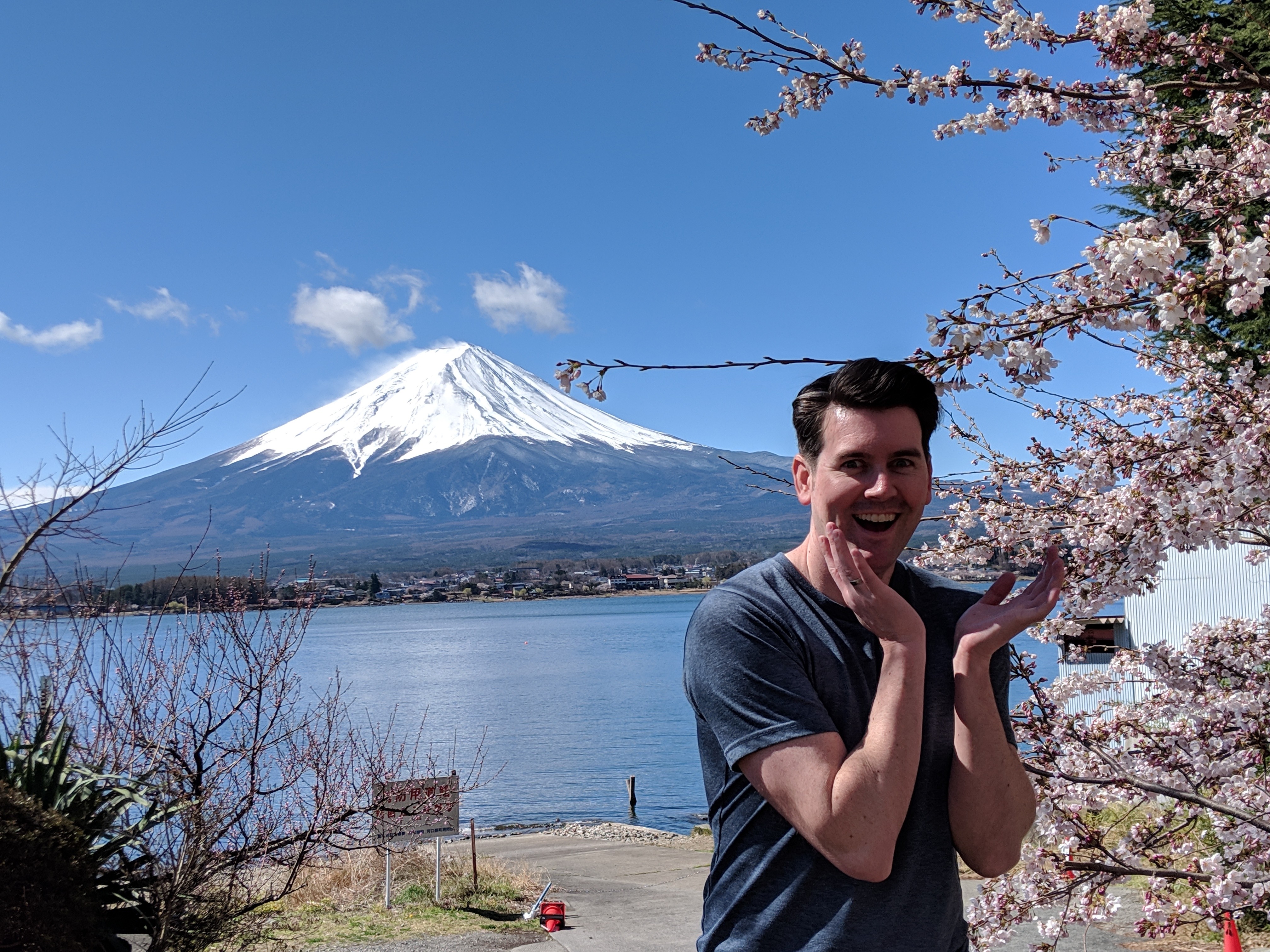
We can't take him anywhere
Motosuko, Fuji Shibazakura Matsuri, and Iyashi no Sato
The plan for the day was to hit three spots, then make our way back to Tokyo in the late afternoon/evening. We started the day with a hike (YAY) at a trail near a lake called Motosu (the suffix “ko” means “lake” so saying “Lake Motosuko” is like “ATM machine” but if you search Google for “Lake Motosuko” you get a bajillion results so whatever). Seri had OKed the hike with me beforehand, though, so I had no right to complain. I was looking forward to the destination, so it wasn’t all that bad. The deal here is that at a certain vista, you get a few of Mt. Fuji set against the lake with its mirror image and it’s just… perfect. In fact, the image is so iconic that it’s on the reverse side of the 1,000 yen note. And unlike the previous day’s pagoda photo op, this one was nearly devoid of people, which was a nice little bonus.
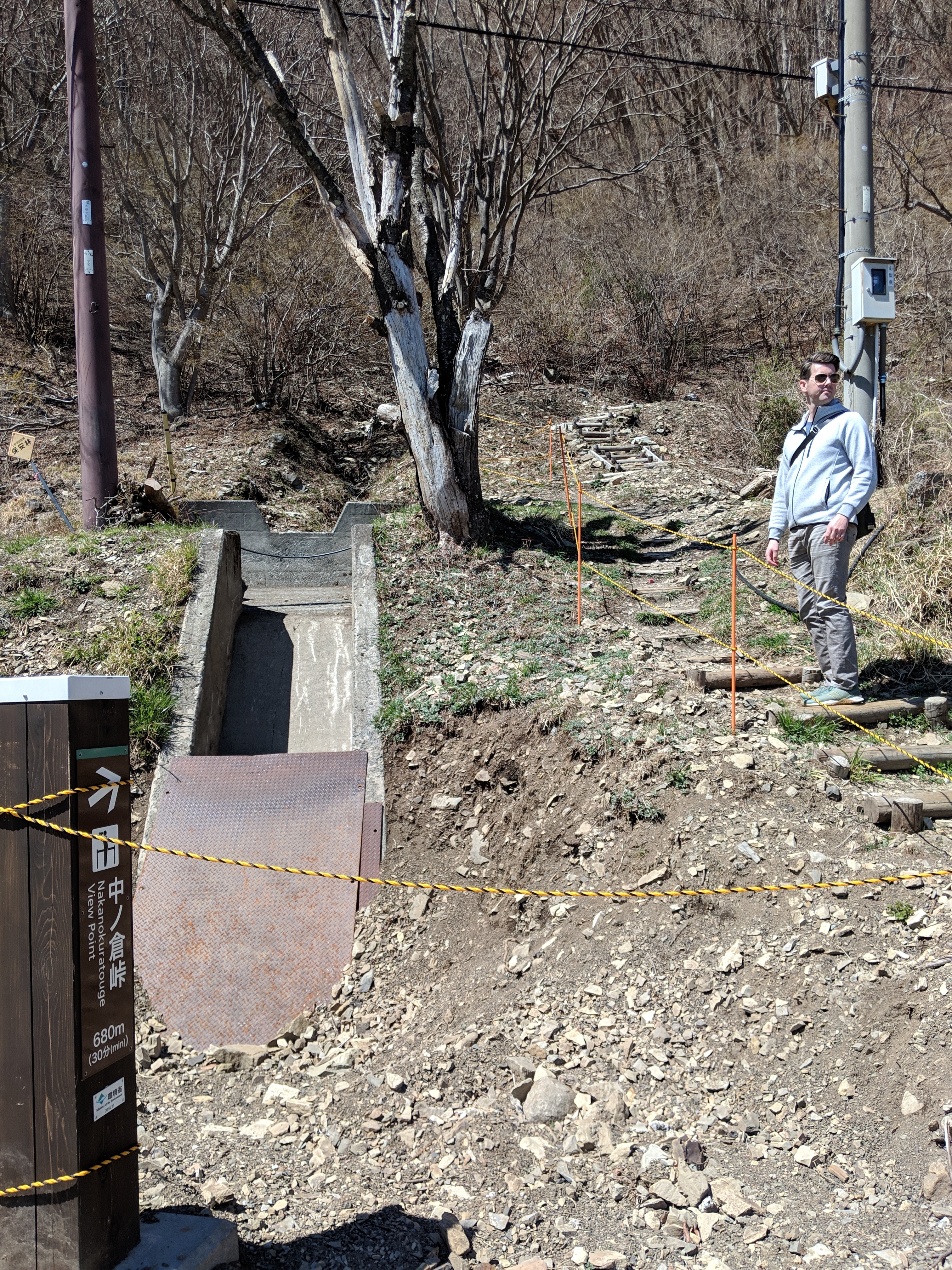
I hiked.
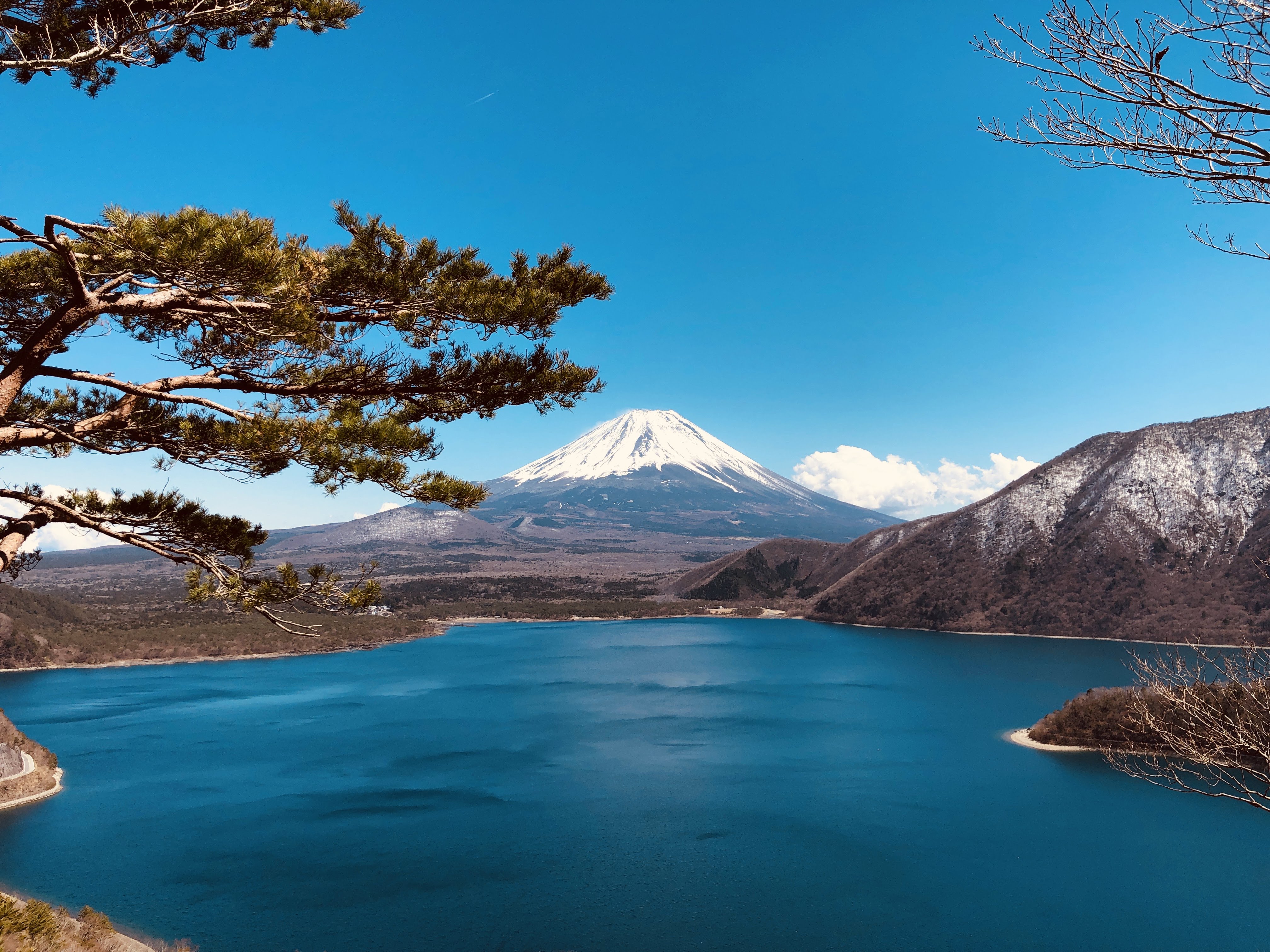
But it was so worth it! (yes this photo is doctored, sue me)
Our next stop was to the Fuji Shibazakura Matsuri (a pink moss festival) that houses hundreds of thousands of flowers. In full bloom, the view is supposed to be incredible. At least we’re told. That day, things just weren’t “there” yet, but that’s how it goes when it comes to these things. I guess it’s better in May. This is what it can look like, but you’ll note that things aren’t nearly as lush in our photos. Oh well. Oh also, lots of tourists picking flowers and bending stalks here, too. People are just so FUN!
We spent a fair amount of time at the festival, but without the full bloom, there was only so much you could really take in. They had a magician and a number of food stalls, though, so they had that going for them. Also I guess a hot-air balloon situation that I noped out of pretty hard. I seem to recall Seri saying it was too windy that day anyway. Darn…
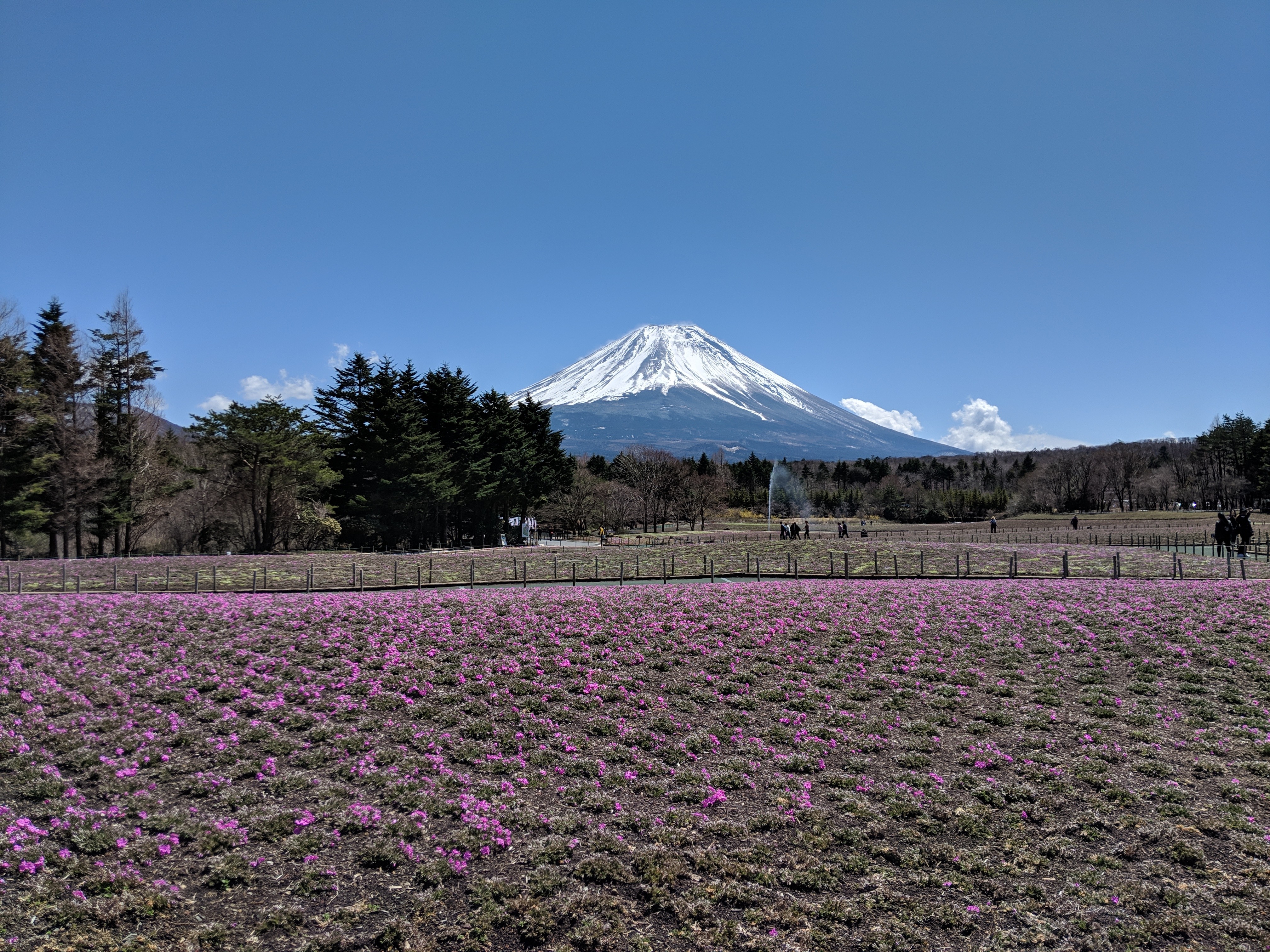
We were a few weeks too early for the full bloom
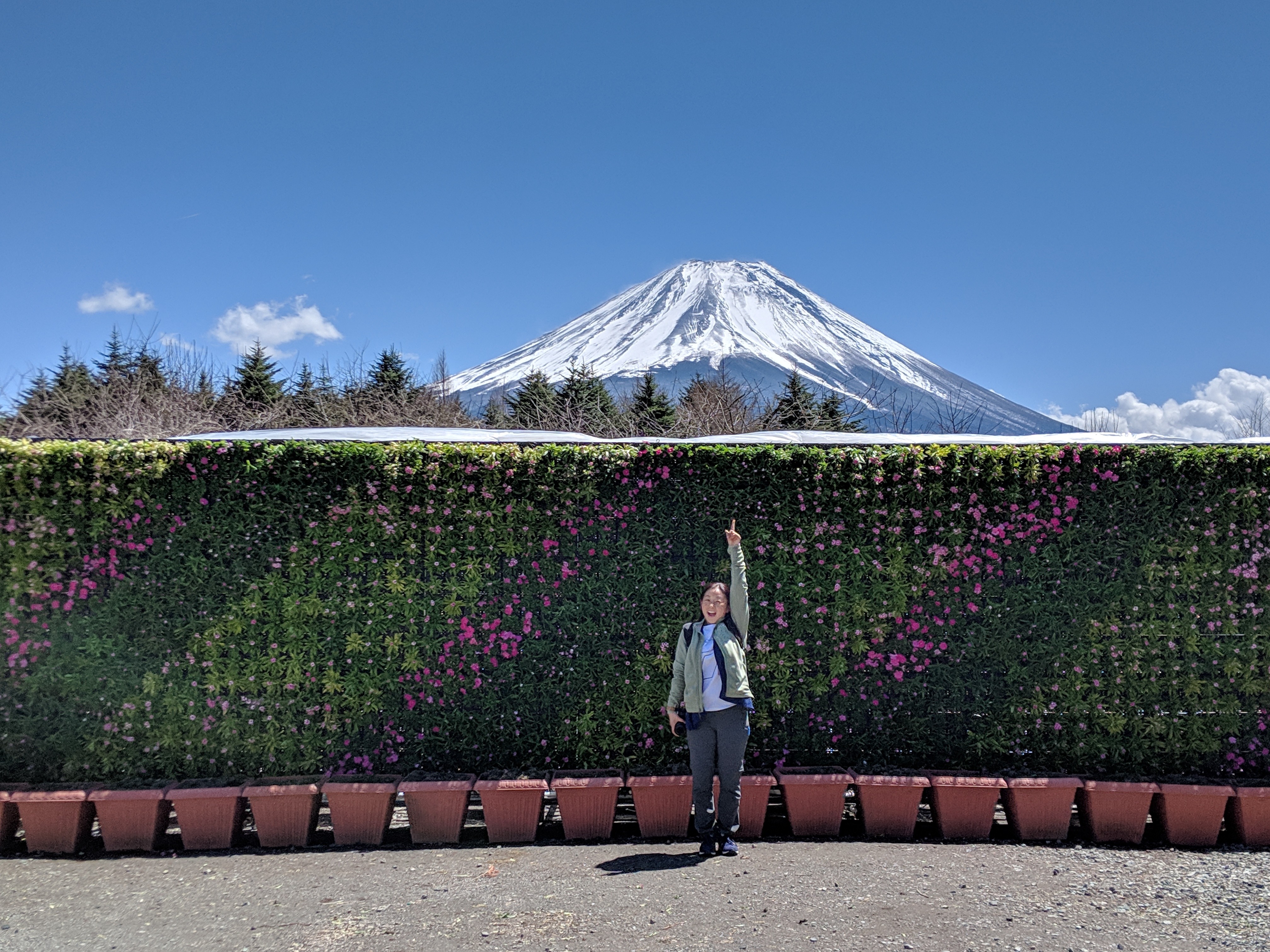
Obligatory flowers + Fuji shot
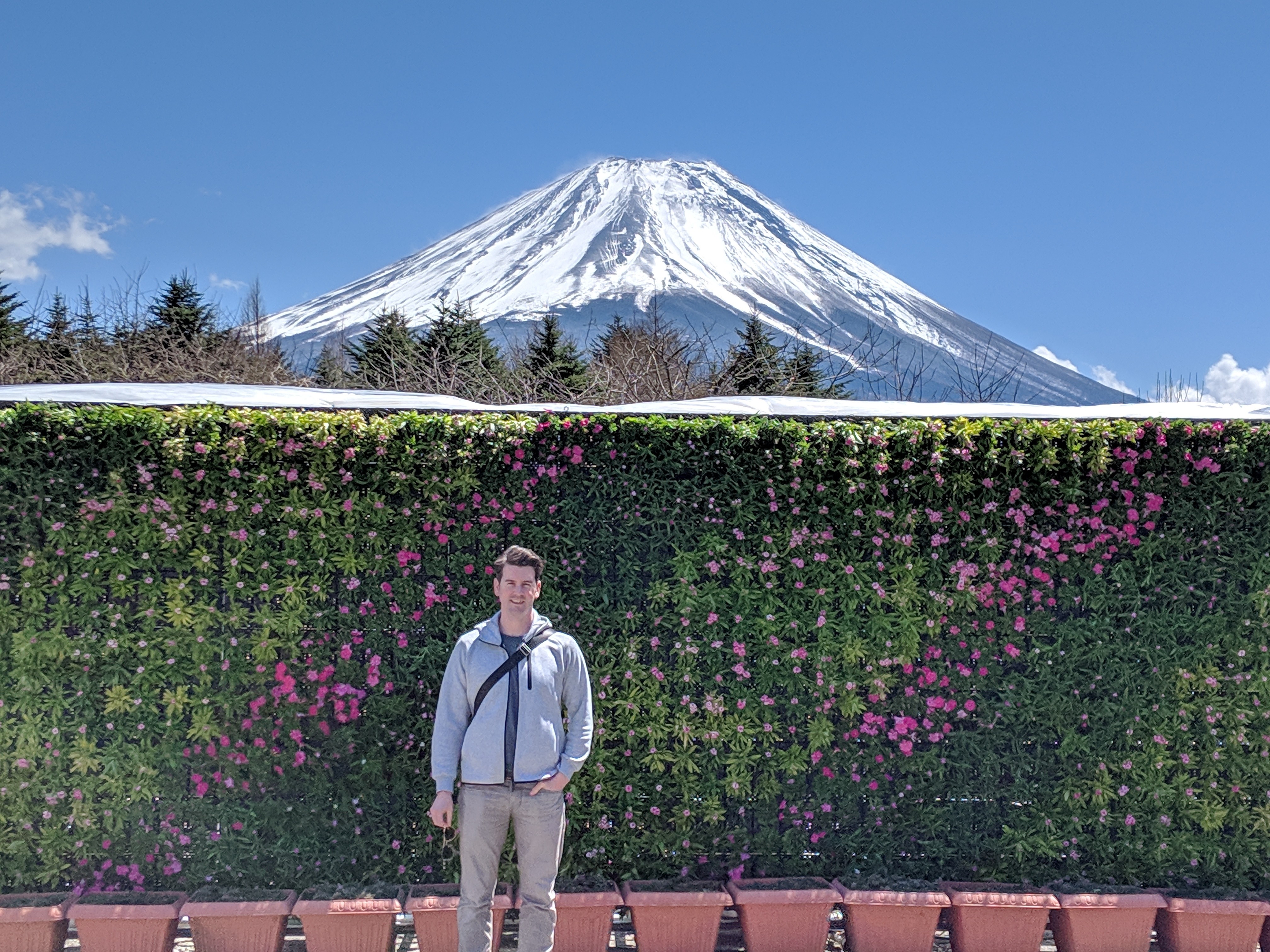
Now with 100% more Adam!
Onto Iyashi no Sato, a recreation of a nearby historic farming village. There were ~25 huts with descriptions of each hut’s responsibility in the community. Even though the village was destroyed by a landslide in 1966, it still felt old. I guess that means they did a pretty good job during the reconstruction. It felt a bit kitchy, though. You could — and some “adorable” children had — rent fake samurai armor and swords (what fun! a couple of 10-year-old boys hacking the air near reconstructed, ancient Japanese huts), and all of the huts now housed various vendors selling things ranging from art, to handmade food, to cheap, themed Mt. Fuji toys. It was kind of a bust, but you could still see Mt. Fuji in the distance, and I appreciated the historic nature of the village and what it might feel like to live in such a small community. One of the huts even served as the equivalent of a modern-day fire station! I guess someone had to.
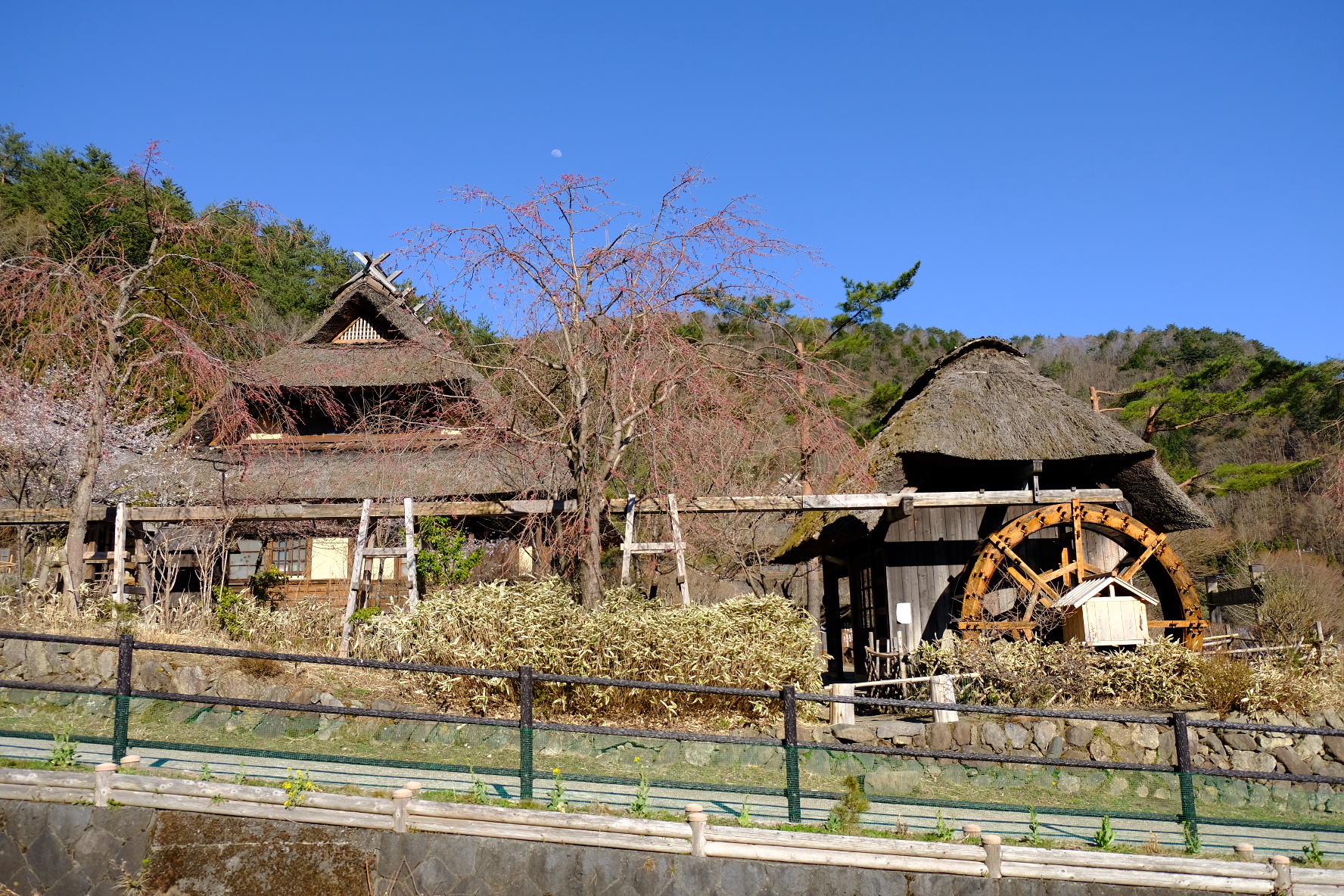
The reconstructed village of Iyashi no Sato
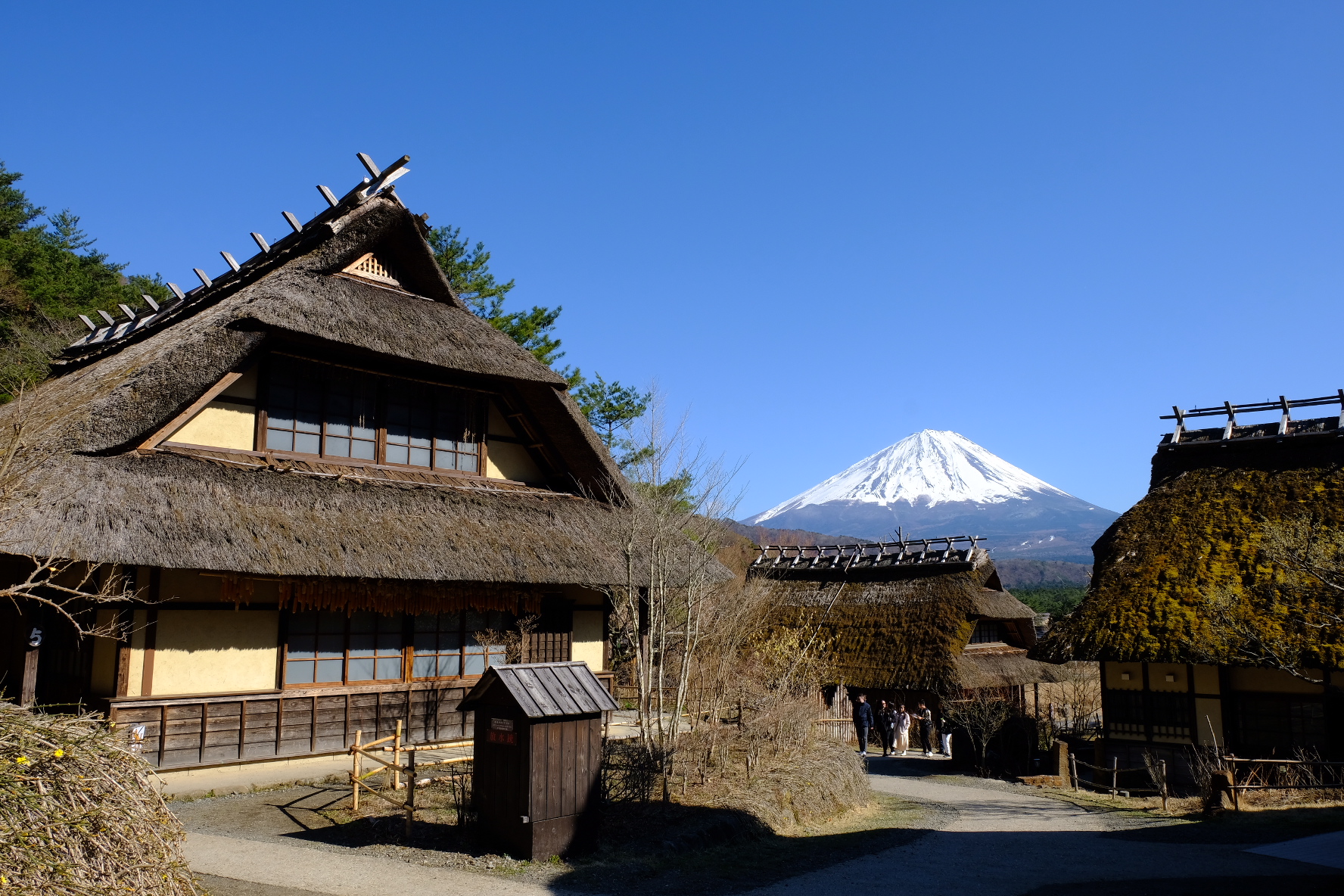
The village's view of Mt. Fuji
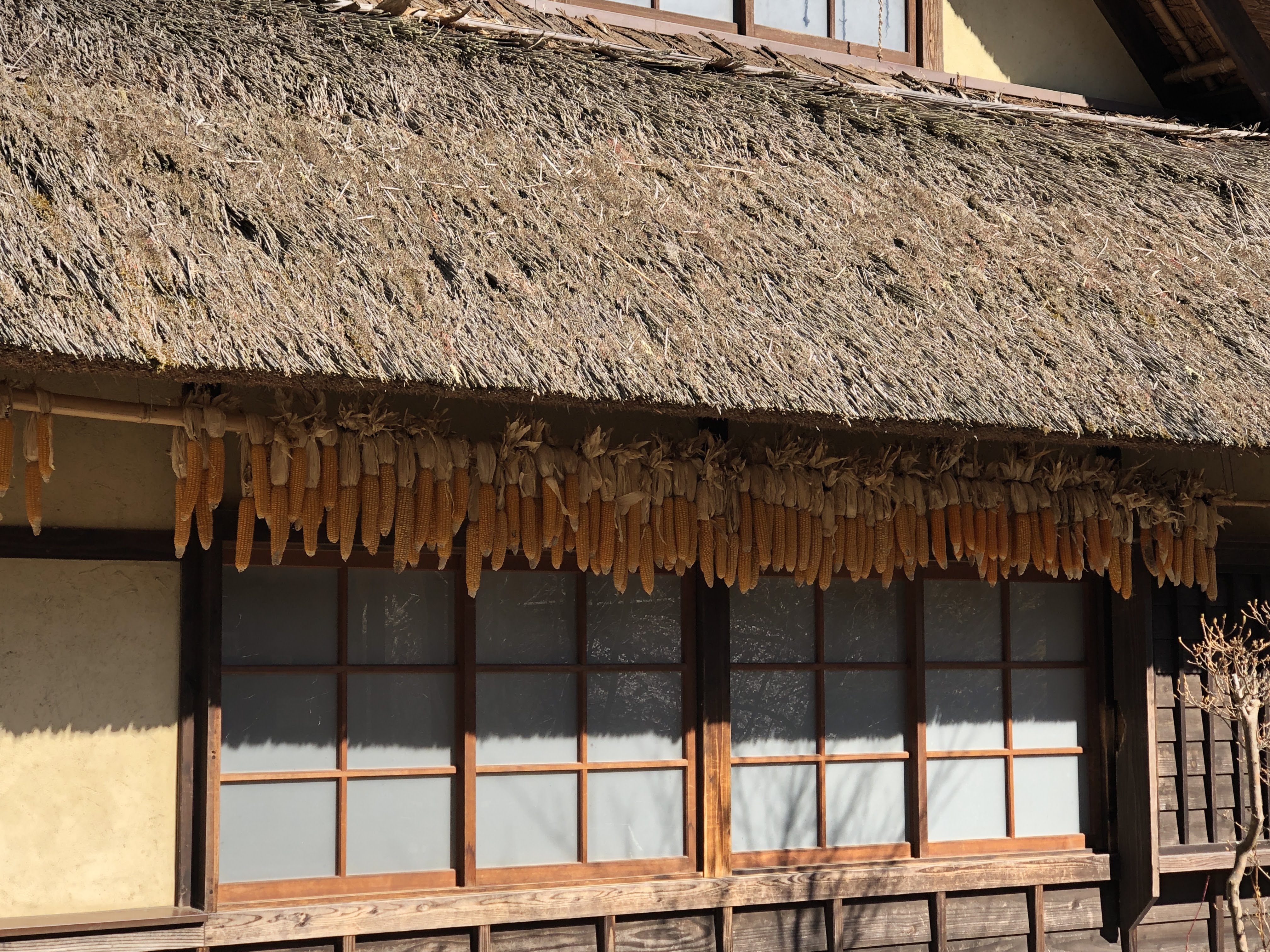
Just drying some corn, no biggie
Back to Tokyo
My stay this trip was abbreviated. Although Fujisan was my main attraction, Seri and Julie had another appointment at a wedding in Hong Kong later in the week. This meant that we needed to drive back to Tokyo that evening, where we’d head back to the Omo5 hotel. The next afternoon, I’d head home to Hakodate, while Seri and Julie would continue on to the wedding a few days later (after hitting up Tokyo Disney Sea… I made a huge mistake planning my departure).
We got back to Tokyo, I turned the rental car on what ended up being a red light and got honked at viciously by a taxi driver (look, the light was green but the lights out here are weird and I guess the left-turn arrow was red but come on, it’s confusing — really looking forward to that driver license exam in June!), and we got back to the hotel without further incident. We ate some ramen for dinner, but generally took it easy since it had been a pretty full day.
The next morning, I woke up early, did some work at the hotel’s cafe, then headed out towards Haneda (with a quick stop at Shinagawa Station to nab some Blue Bottle beans) to catch my flight back to Hakodate. It had been a quick three-day trip, but we’d managed to pack a lot into it, and I’m glad we accomplished what we’d set out to do.
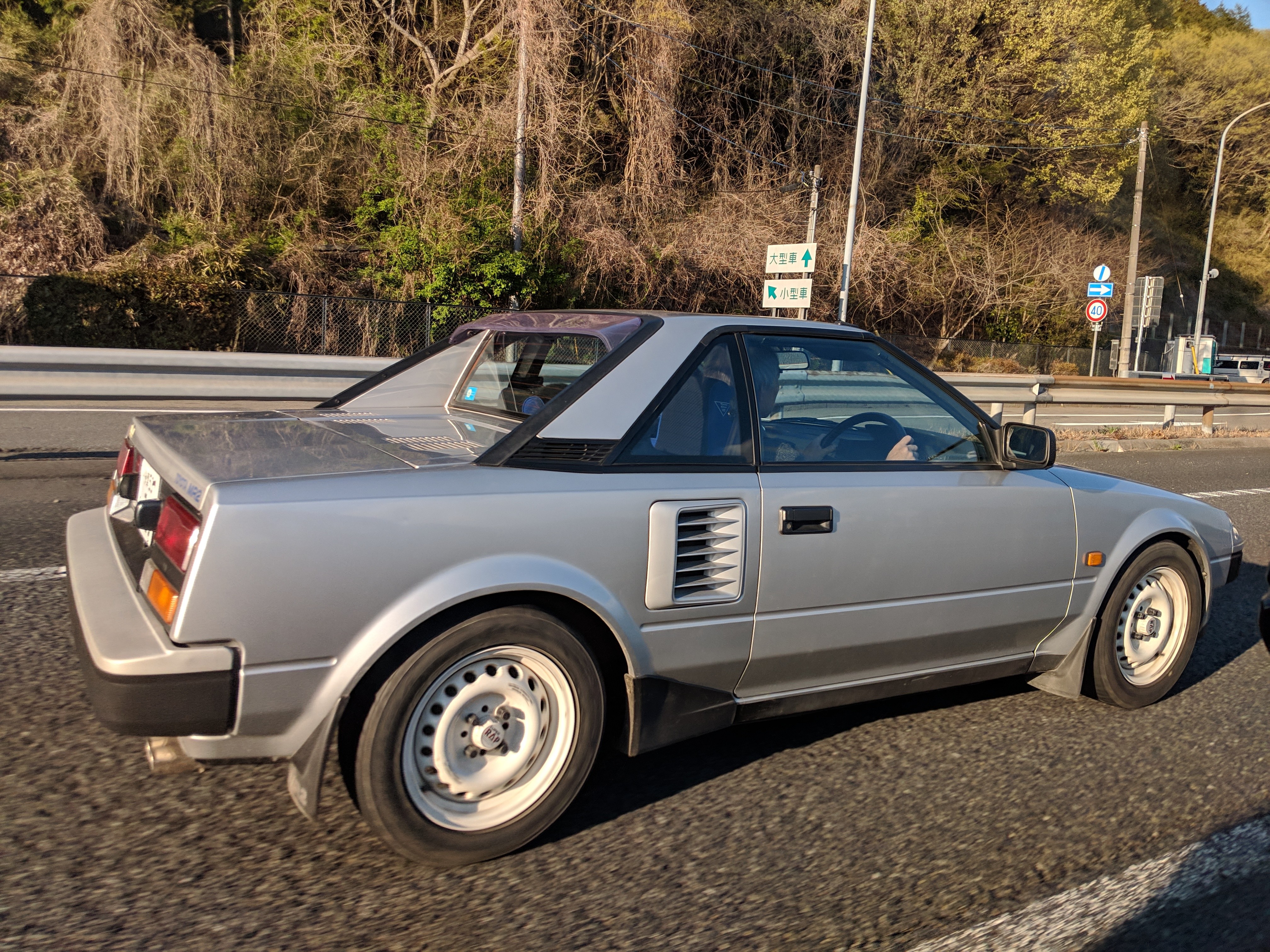
Bonus MR2 pic Seri snapped during our drive back to Tokyo!